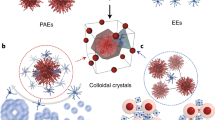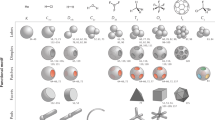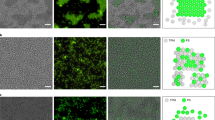Abstract
In principle, designing and synthesizing almost any class of colloidal crystal is possible. Nonetheless, the deliberate and rational formation of colloidal quasicrystals has been difficult to achieve. Here we describe the assembly of colloidal quasicrystals by exploiting the geometry of nanoscale decahedra and the programmable bonding characteristics of DNA immobilized on their facets. This process is enthalpy-driven, works over a range of particle sizes and DNA lengths, and is made possible by the energetic preference of the system to maximize DNA duplex formation and favour facet alignment, generating local five- and six-coordinated motifs. This class of axial structures is defined by a square–triangle tiling with rhombus defects and successive on-average quasiperiodic layers exhibiting stacking disorder which provides the entropy necessary for thermodynamic stability. Taken together, these results establish an engineering milestone in the deliberate design of programmable matter.
This is a preview of subscription content, access via your institution
Access options
Access Nature and 54 other Nature Portfolio journals
Get Nature+, our best-value online-access subscription
$29.99 / 30 days
cancel any time
Subscribe to this journal
Receive 12 print issues and online access
$259.00 per year
only $21.58 per issue
Buy this article
- Purchase on Springer Link
- Instant access to full article PDF
Prices may be subject to local taxes which are calculated during checkout




Similar content being viewed by others
Data availability
All the data supporting the findings of this study are included in the Article and its Supplementary Information files, and are available from the corresponding author on reasonable request.
Code availability
Source code for HOOMD-blue is available at https://github.com/glotzerlab/hoomd-blue.
References
Mirkin, C. A., Letsinger, R. L., Mucic, R. C. & Storhoff, J. J. A DNA-based method for rationally assembling nanoparticles into macroscopic materials. Nature 382, 607–609 (1996).
Jones, M. R., Seeman, N. C. & Mirkin, C. A. Programmable materials and the nature of the DNA bond. Science 347, 1260901 (2015).
Winfree, E., Liu, F., Wenzler, L. A. & Seeman, N. C. Design and self-assembly of two-dimensional DNA crystals. Nature 394, 539–544 (1998).
Laramy, C. R., O’Brien, M. N. & Mirkin, C. A. Crystal engineering with DNA. Nat. Rev. Mater. 4, 201–224 (2019).
Shechtman, D., Blech, I., Gratias, D. & Cahn, J. W. Metallic phase with long-range orientational order and no translational symmetry. Phys. Rev. Lett. 53, 1951 (1984).
Glotzer, S. Quasicrystals: the thrill of the chase. Nature 565, 156–159 (2019).
Steinhardt, P. The Second Kind of Impossible: The Extraordinary Quest for a New Form of Matter (Simon & Schuster, 2019).
Wang, N., Chen, H. & Kuo, K. Two-dimensional quasicrystal with eightfold rotational symmetry. Phys. Rev. Lett. 59, 1010 (1987).
Chen, H., Li, D. & Kuo, K. New type of two-dimensional quasicrystal with twelvefold rotational symmetry. Phys. Rev. Lett. 60, 1645 (1988).
Li, X. & Kuo, K. Decagonal quasicrystals with different periodicities along the tenfold axis in rapidly solidified Al–Ni alloys. Philos. Mag. Lett. 58, 167–171 (1988).
Talapin, D. V. et al. Quasicrystalline order in self-assembled binary nanoparticle superlattices. Nature 461, 964–967 (2009).
Nagaoka, Y., Zhu, H., Eggert, D. & Chen, O. Single-component quasicrystalline nanocrystal superlattices through flexible polygon tiling rule. Science 362, 1396–1400 (2018).
Haji-Akbari, A. et al. Disordered, quasicrystalline and crystalline phases of densely packed tetrahedra. Nature 462, 773–777 (2009).
Haji-Akbari, A., Engel, M. & Glotzer, S. C. Degenerate quasicrystal of hard triangular bipyramids. Phys. Rev. Lett. 107, 215702 (2011).
Je, K., Lee, S., Teich, E. G., Engel, M. & Glotzer, S. C. Entropic formation of a thermodynamically stable colloidal quasicrystal with negligible phason strain. Proc. Natl Acad. Sci. USA 118, e2011799118 (2021).
Damasceno, P. F., Engel, M. & Glotzer, S. C. Predictive self-assembly of polyhedra into complex structures. Science 337, 453–457 (2012).
Cersonsky, R. K., van Anders, G., Dodd, P. M. & Glotzer, S. C. Relevance of packing to colloidal self-assembly. Proc. Natl Acad. Sci. USA 115, 1439–1444 (2018).
Sánchez-Iglesias, A. et al. High-yield seeded growth of monodisperse pentatwinned gold nanoparticles through thermally induced seed twinning. J. Am. Chem. Soc. 139, 107–110 (2017).
Auyeung, E. et al. DNA-mediated nanoparticle crystallization into Wulff polyhedra. Nature 505, 73–77 (2014).
Auyeung, E., Macfarlane, R. J., Choi, C. H. J., Cutler, J. I. & Mirkin, C. A. Transitioning DNA‐engineered nanoparticle superlattices from solution to the solid state. Adv. Mater. 24, 5181–5186 (2012).
Lin, H. et al. Clathrate colloidal crystals. Science 355, 931–935 (2017).
Oxborrow, M. & Henley, C. L. Random square–triangle tilings: a model for twelvefold-symmetric quasicrystals. Phys. Rev. B 48, 6966 (1993).
Nugent, P. J. et al. Step-terrace morphology and reactivity to C60 of the five-fold icosahedral Ag–In–Yb quasicrystal. Philos. Mag. 91, 2862–2869 (2011).
Heilbronner, R. P. The autocorrelation function: an image processing tool for fabric analysis. Tectonophysics 212, 351–370 (1992).
Gähler, F. in Quasicrystalline Materials: Proceedings of the ILL/CODEST Workshop (eds Janot, C. & Dubois, J.) 272–284 (World Scientific, 1988).
Ishimasa, T., Nissen, H.-U. & Fukano, Y. New ordered state between crystalline and amorphous in Ni–Cr particles. Phys. Rev. Lett. 55, 511 (1985).
Ishimasa, T., Iwami, S., Sakaguchi, N., Oota, R. & Mihalkovič, M. Phason space analysis and structure modelling of 100 Å-scale dodecagonal quasicrystal in Mn-based alloy. Philos. Mag. 95, 3745–3767 (2015).
Stampfli, P. A dodecagonal quasi-periodic lattice in 2 dimensions. Helv. Chim. Acta 59, 1260–1263 (1986).
Ritsch, S., Nissen, H.-U. & Beeli, C. Phason related stacking disorder in decagonal Al–Co–Ni. Phys. Rev. Lett. 76, 2507 (1996).
Shin, M. & Strandburg, K. J. Random tiling approach to the structure of decagonal quasicrystals. J. Non Cryst. Solids 153, 253–257 (1993).
Jeong, H.-C. & Steinhardt, P. J. Finite-temperature elasticity phase transition in decagonal quasicrystals. Phys. Rev. B 48, 9394 (1993).
Edagawa, K., Suzuki, K. & Takeuchi, S. HRTEM observation of phason flips in Al–Cu–Co decagonal quasicrystal. J. Alloy. Compd. 342, 271–277 (2002).
Jones, M. R. et al. DNA–nanoparticle superlattices formed from anisotropic building blocks. Nat. Mater. 9, 913–917 (2010).
Anderson, J. A., Irrgang, M. E. & Glotzer, S. C. Scalable Metropolis Monte Carlo for simulation of hard shapes. Comput. Phys. Commun. 204, 21–30 (2016).
Anderson, J. A., Glaser, J. & Glotzer, S. C. HOOMD-blue: a Python package for high-performance molecular dynamics and hard particle Monte Carlo simulations. Comput. Mater. Sci. 173, 109363 (2020).
Glaser, J. et al. Strong scaling of general-purpose molecular dynamics simulations on GPUs. Comput. Phys. Commun. 192, 97–107 (2015).
Towns, J. et al. XSEDE: accelerating scientific discovery. Comput. Sci. Eng. 16, 62–74 (2014).
Haji-Akbari, A., Engel, M. & Glotzer, S. C. Phase diagram of hard tetrahedra. J. Chem. Phy. 135, 194101 (2011).
Frenkel, D. & Ladd, A. J. New Monte Carlo method to compute the free energy of arbitrary solids. Application to the fcc and hcp phases of hard spheres. J. Chem. Phy. 81, 3188–3193 (1984).
Chandler, D., Weeks, J. D. & Andersen, H. C. Van der Waals picture of liquids, solids, and phase transformations. Science 220, 787–794 (1983).
Spellings, M., Marson, R. L., Anderson, J. A. & Glotzer, S. C. GPU accelerated discrete element method (DEM) molecular dynamics for conservative, faceted particle simulations. J. Comput. Phys. 334, 460–467 (2017).
van Damme, R., Coli, G. M., van Roij, R. & Dijkstra, M. Classifying crystals of rounded tetrahedra and determining their order parameters using dimensionality reduction. ACS Nano 14, 15144–15153 (2020).
Acknowledgements
This material is based upon work supported by the Air Force Office of Scientific Research under awards FA9550-17-1-0348 and FA9550-22-1-0300 (nanoparticle synthesis and assembly); the Center for Bio-Inspired Energy Science, an Energy Frontier Research Center funded by the US Department of Energy, Office of Science, Basic Energy Sciences under award DE-SC0000989 (oligonucleotide synthesis); and the Sherman Fairchild Foundation, Inc. (EM characterization). Z.H. acknowledges support by the NU Graduate School Cluster in Biotechnology, Systems, and Synthetic Biology, which is affiliated with the Biotechnology Training Program funded by NIGMS grant T32 GM008449. This work made use of the EPIC facility of the NUANCE Center at NU, which has received support from the Soft and Hybrid Nanotechnology Experimental (SHyNE) Resource (NSF DMR-1720139 and NNCI-1542205); the International Institute for Nanotechnology (IIN); the Keck Foundation; and the State of Illinois, through the IIN. The simulation work is supported as part of the Center for Bio-Inspired Energy Science, an Energy Frontier Research Center funded by the US Department of Energy, Office of Science, Basic Energy Sciences under award number DE-SC0000989. This work uses the Extreme Science and Engineering Discovery Environment (XSEDE), which is supported by National Science Foundation grant number ACI-1548562; XSEDE award DMR 140129. This research was supported in part through computational resources and services supported by Advanced Research Computing at the University of Michigan, Ann Arbor. L.M.L.-M. acknowledges funding from the Spanish Ministry of Science and Innovation (grant number PID2020-117779R) and the Maria de Maeztu Units of Excellence Program from the Spanish State Research Agency (grant number MDM-2017-0720). This research used resources of the Advanced Photon Source, a US Department of Energy (DOE) Office of Science user facility at Argonne National Laboratory and is based on research supported by the US DOE Office of Science-Basic Energy Sciences, under contract number DE-AC02-06CH11357.
Author information
Authors and Affiliations
Contributions
W.Z., Y. Li, A.S.-I. and M.G. synthesized the nanoparticles. W.Z., H.L. and Y. Li performed the colloidal crystallization and material characterization. Y. Lim and S.L. designed and performed the simulations. B.L. contributed SAXS data interpretation and simulation. S.C.G., L.M.L.-M. and C.A.M. supervised the project. All authors analysed the data, interpreted the data and contributed to the writing of the manuscript.
Corresponding authors
Ethics declarations
Competing interests
The authors declare no competing interests.
Peer review
Peer review information
Nature Materials thanks Chengde Mao, Walter Steurer and the other, anonymous, reviewer(s) for their contribution to the peer review of this work.
Additional information
Publisher’s note Springer Nature remains neutral with regard to jurisdictional claims in published maps and institutional affiliations.
Extended data
Extended Data Fig. 1 Stacking behaviour of S1 and S2 tiles of DDQC.
(a) Top and side views of a column of S1 tiles. Connecting the centres of only red particles gives triangle tiles and connecting the centres of only green particles gives square tiles of the smallest length scale (S1). (b) Top and side views of a column of inflated (S2) square tiles. Connecting the centres of blue particles give S2 square tiles. Connecting the centres of both blue and yellow particles give S1 square and triangle tiles decomposing the S2 square tiles. The S2 square tile is uniform along the column. The decomposition is not unique and can be alternating along the column as shown in the image. (c) Top and side views of a column of inflated (S2) triangle tiles. The S1 tiles decomposing the S2 triangle tiles show different configurations along the column.
Extended Data Fig. 2 FFT analysis of a simulated DNA-functionalized decahedron DDQC.
FFT results calculated from (a) a slab and (b) a whole sample. (c, d) Side view of the whole DDQC sample from different orientations. This sample is the same sample with Fig. 2g, and each sphere represents the centre of a decahedron. The FFT pattern in (a) was calculated from a slab in the purple-dashed box in (c). The FFT pattern in (b) was calculated from a whole sample, and it shows line-like features (red arrows) together with dominant peaks. It is attributed to the existence of a subdomain in the black-dashed box whose 12-fold symmetry is slightly rotated from the overall 12-fold symmetry.
Extended Data Fig. 3 Densest packing of hard rounded decahedra.
(a, b) SEM images of a triclinic crystalline structure formed by slow-drying decahedral NPs on a surface. (c) Comparison of the highest packing fraction (\(N\times {v}_{0}/{V}_{{\rm{Box}}}\), where v0 is the volume of a particle) for four simulated structures: Quasicrystal Approximant (QA) (Supplementary Fig. 14), Triclinic (Tri), Rhombohedral (Rh), and Hexagonal (Hex), with increasing rounding radius (lrr) of the hard decahedra. Solid markers are the packing fraction of the densest crystals obtained from the packing simulations of systems with N = 2 or 4. Open markers are the maximum packing fractions of each phase obtained by compressing the constructed crystal structures (Methods). (d–g) Structural illustration of rounded decahedra (\({l}_{{rr}}/{l}_{{edge}} \sim 0.18\)) packed into the four crystalline lattices.
Supplementary information
Supplementary Information
Supplementary Figs 1–26 and Tables 1–3.
Rights and permissions
Springer Nature or its licensor (e.g. a society or other partner) holds exclusive rights to this article under a publishing agreement with the author(s) or other rightsholder(s); author self-archiving of the accepted manuscript version of this article is solely governed by the terms of such publishing agreement and applicable law.
About this article
Cite this article
Zhou, W., Lim, Y., Lin, H. et al. Colloidal quasicrystals engineered with DNA. Nat. Mater. 23, 424–428 (2024). https://doi.org/10.1038/s41563-023-01706-x
Received:
Accepted:
Published:
Issue Date:
DOI: https://doi.org/10.1038/s41563-023-01706-x



